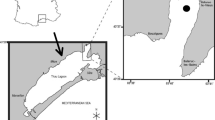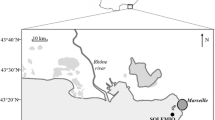Summary
Heterotrophic activity in the bottom few cm of annual sea ice in the Canadian Arctic was measured throughout the spring bloom of ice algae, using tritium-labelled thymidine and glucose. Experiments with chloramphenicol and cyclohexamide indicated that thymidine assimilation was due to procaryotic microbes but that about half of the glucose assimilation was due to eucaryotic organisms. Glucose and thymidine assimilation rates increased with salinity, from 10 ppt to 30 ppt. Thymidine assimilation rates increased from 1.16 to 4.94·10−21mol·cell−1·h−1 during the latter half of the algal bloom, while the exponential growth rate of the in situ populations decreased from 0.058 to 0.025 d−1. Bacterial production and specific growth rates calculated from thymidine assimilation were 149mgC·m−2 and 0.25 d−1 or less respectively over the 50 day observation period, compared with net primary production of 5,500 mgC·m−2. Thymidine assimilation rates suggested that about half of the bacterial production may be consumed or lost from the ice during the bloom.
Similar content being viewed by others
References
Bates SS, Cota GF (1986) Fluorescence induction and photosynthetic responses of arctic ice algae to sample treatment and salinity. J Phycol 22: 421–419
Bell RT (1986) Further verification of the isotope dilution approach for estimating the degree of participation of [3H]thymidine in DNA synthesis in studies of aquatic bacterial production. Appl Environ Microbiol 52: 1212–1214
Bradstreet MSW, Cross WE (1982) Trophic relationships at high arctic ice edges. Arctic 35: 1–12
Bratback G, Dundas I (1984) Bacterial dry matter content and biomass estimations. Appl Environ Microbiol 48: 755–767
Carey AG Jr (1987) Particle flux beneath fast ice in the shallow southwestern Beaufort Sea, Arctic Ocean. Mar Ecol Prog Ser 40: 247–257
Chin-Leo G, Kirchman DL (1988) Estimating bacterial production in marine waters from the simultaneous incorporation of thymidine and leucine. Appl Environ Microbiol 54: 1934–1939
Conover RJ, Herman AW, Prinsenberg SJ, Harris LR (1986) Distribution of and feeding by the copepod Pseudocalanus under fast ice during the arctic spring. Science 232: 1245–1247
Cota GF, Prinsenberg SJ, Bennett EB, Loder JW, Lewis MR, Anning JA, Watson NH, Harris LR (1987) Nutrient flux during extended blooms of arctic ice algae. J Geophys Res 92(C): 1951–1962
Coveney MF, Wetzel RG (1988) Experimental evaluation of conversion factors for the [3H]Thymidine incorporation assay of bacterial secondary productivity. Appl Environ Microbiol 54: 2018–2026
Cross WE (1982) Under ice biota at the Pond Inlet ice edge and in adjacent fast ice areas during spring. Arctic 35: 13–27
Ducklow HW (1983) Production and fate of bacteria in the oceans. Bioscience 33: 491–500
Ducklow HW, Hill SM (1985a) The growth of heterotrophic bacteria in the surface waters of warm core rings. Limnol Oceanogr 30: 239–259
Ducklow HW, Hill SM (1985b) Tritiated thymidine incorporation and the growth of heterotrophic bacteria in warm core rings. Limnol Oceanogr 30: 260–272
Findlay SEG, Meyer JL, Edwards RT (1984) Measuring bacterial production via rate of incorporation of 3H-thymidine into DNA. J Microbiol Methods 2: 57–72
Fuhrman JA, Azam F (1982) Thymidine incorporation as a measure of heterotrophic bacterioplankton production in marine surface waters: evaluation and field results. Mar Biol 66: 109–120
Garrison DL, Sullivan CW, Ackley SF (1986) Sea ice microbial communities in Antarctica. Bioscience 36: 243–250
Grainger EH, Mohammed AI, Lovrity JE (1985) The sea ice fauna of Frobisher Bay, Arctic Canada. Arctic 38: 23–30
Griffiths RP, Caldwell BA, Morita RY (1982) Seasonal changes in microbial heterotrophic activity in subarctic marine waters as related to phytoplankton primary productivity. Mar Biol 71: 121–127
Grossi SM, Kottmeier S, Sullivan CW (1984) Sea ice microbial communities III Seasonal abundance of microalgae and associated bacteria, McMurdo Sound, Antarctica. Microbiol Ecol 10: 231–242
Grossi SM, Kottmeier ST, Moe RL, Taylor GT, Sullivan CW (1987) Sea ice microbial communities VI Growth and primary production in bottom ice under graded snow cover. Mar Ecol Prog Ser 35: 153–164
Hollibaugh JT (1988) Limitations of the 3H-thymidine method for estimating bacterial productivity due to thymidine metabolism. Mar Ecol Prog Ser 43: 19–30
Horner RA (1985) Ecology of sea ice microalgae. In Horner RA (ed) Sea ice biota. CRC Press, Boca Raton Florida, pp 83–103
Horner RA, Alexander V (1972) Algal populations in arctic sea ice: An investigation of heterotrophy. Limnol Oceanogr 17: 454–461
Hsiao SIC (1987) Sedimentation in Arctic Canada: Species composition and biomass of phytoplankton contributed to the marine sediments in Frobisher Bay. Polar Biol 7: 245–251
Kottmeier ST, Sullivan CW (1987) Late winter primary production and bacterial production in sea ice and seawater west of the Antarctic Peninsula. Mar Ecol Prog Ser 36: 287–298
Kottmeier ST, Sullivan CW (1988) Sea ice microbial communities (SIMCO) 9 Effects of temperature and salinity on rates of metabolism and growth of autotrophs and heterotrophs. Polar Biol 8: 293–304
Kottmeier ST, Grossi SM, Sullivan CW (1987) Sea ice microbial communities VIII Bacterial production in annual sea ice of McMurdo Sound Antarctica. Mar Ecol Prog Ser 35: 175–186
Marquardt DW (1963) An algorithm for least-squares estimation of nonlinear parameters. J Soc Indust Appl Math 11: 431–441
Murray RE, Cooksey KE, Priscu JC (1986) Stimulation of bacterial DNA synthesis by algal exudates in attached algal-bacterial consortia. Appl Environ Microbiol 52: 1175–1182
Newell RC (1983) The biological role of detritus in the marine environment. In: Fasham MJ (ed) Flow of energy and materials in marine ecosystems. Plenum Press, New York, NY, pp 317–343
Palmisano AC, Sullivan CW (1985) Growth metabolism and dark survival in sea ice microalgae. In: Horner RA (ed) Sea ice biota. CRC Press, Boca Raton Florida, pp 132–146
Pollard PC, Moriarty JW (1984) Validity of the tritiated thymidine method for estimating bacterial growth rates: measurement of isotope dilution during DNA synthesis. Appl Environ Microbiol 48: 1076–1083
Riemann B (1984) Determining growth rates of natural assemblages of freshwater bacteria by means of 3H-thymidine incorporation into DNA: comments on methodology. Arch Hydrobiol Beih Ergebn Limnol 19: 67–80
Riemann B, Bjornsen PK, Newell S, Fallon R (1987) Calculation of cell production of coastal marine bacteria based on measured incorporation of [3H]thymidine. Limnol Oceanogr 32: 471–476
Rivkin RB (1986) Incorporation of tritiated thymidine by eucaryotic microalgae. J Phycol 22: 193–198
Rivkin RB, Putt M (1987) Heterotrophy and photoheterotrophy by Antarctic microalgae: light-dependent incorporation of amino acids and glucose. J Phycol 23: 442–45
Smith REH, Clement P, Cota GF (1988a) Population dynamics of bacteria in arctic sea ice. Microbiol Ecol 17: 63–76
Smith REH, Anning JA, Clement P, Cota GF (1988b) Abundance and production of ice algae in Resolute Passage, Canadian Arctic. Mar Ecol Prog Ser 48: 251–263
Smith REH, Clement P, Head EJ (1989) Biosynthesis and photosynthate allocation patterns of arctic ice algae. Limnol Oceanogr 34: 591–605
Stretch JJ, Hamner PP, Hamner WN, Michel WC, Cook J, Sullivan CW (1988) Foraging Behaviour of antarctic krill Euphausia superba on sea ice microlgae. Mar Ecol Prog Ser 44: 131–139
Sullivan CW, Palmisano AC (1984) Sea ice microbial communities: distribution abundance and diversity of ice bacteria in McMurdo Sound, Antarctica in 1980. Appl Environ Microbiol 47: 788–795
Taylor GT, Pace ML (1987) Validity of eucaryote inhibitors for assessing production and grazing mortality of marine bacterioplankton. Appl Environ Microbiol 53: 119–128
Vargo GA, Fanning K, Heil C, Bell L (1986) Growth rates and the salinity response of an antarctic ice microflora community. Polar Biol 5: 241–247
Author information
Authors and Affiliations
Rights and permissions
About this article
Cite this article
Smith, R.E.H., Clement, P. Heterotrophic activity and bacterial productivity in assemblages of microbes from sea ice in the high Arctic. Polar Biol 10, 351–357 (1990). https://doi.org/10.1007/BF00237822
Received:
Accepted:
Issue Date:
DOI: https://doi.org/10.1007/BF00237822




